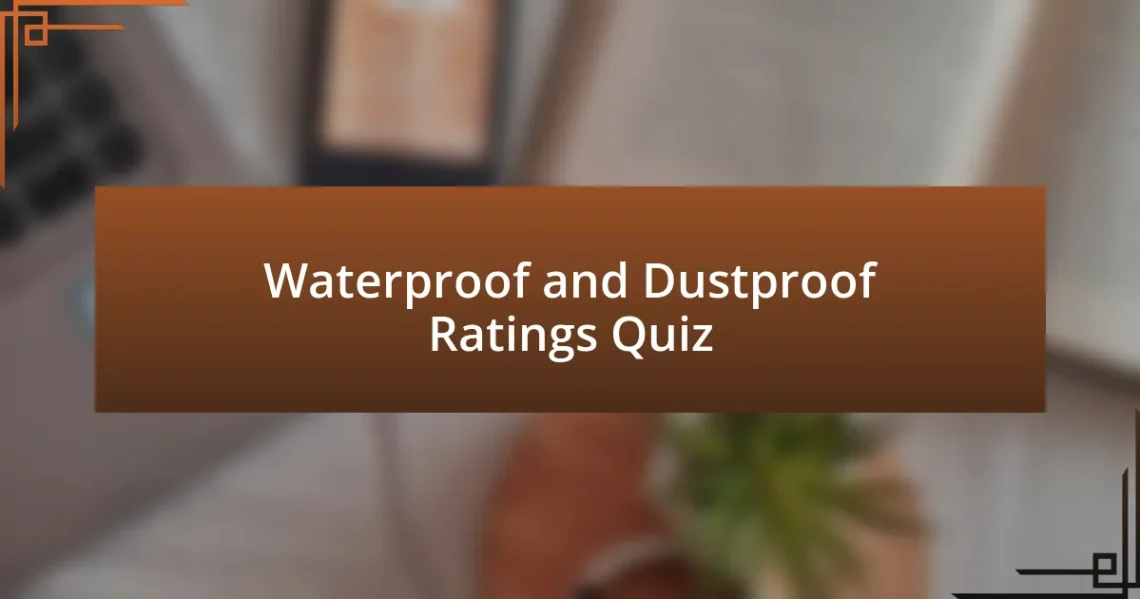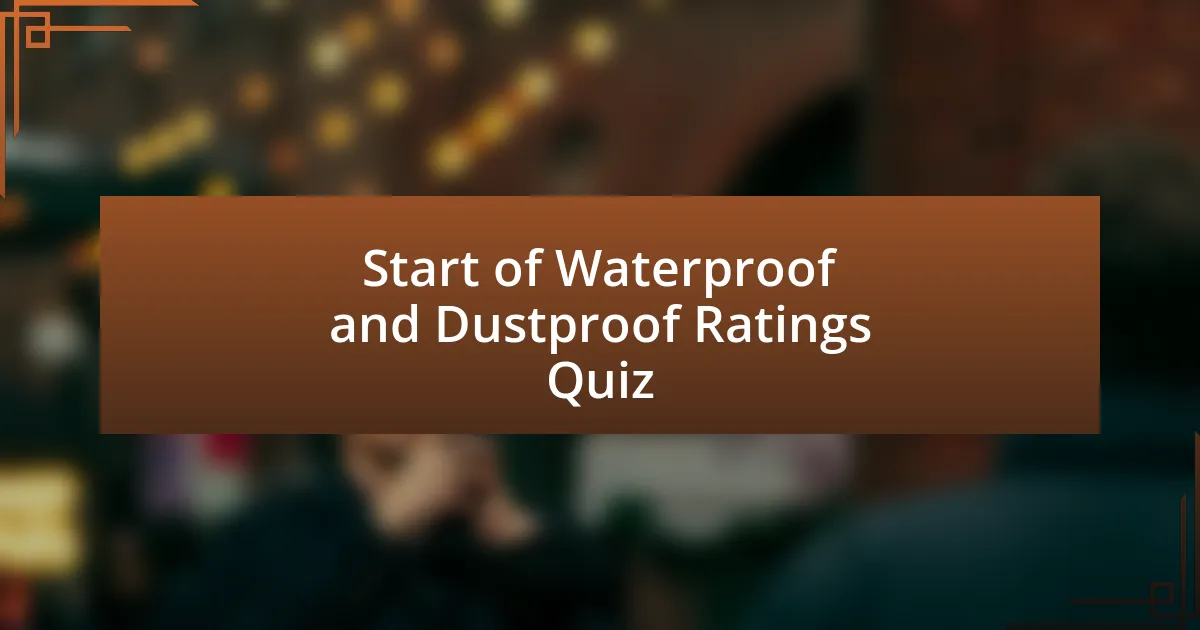
Waterproof and Dustproof Ratings Quiz

Start of Waterproof and Dustproof Ratings Quiz
1. What does the first digit in an IP rating signify?
- Protection against liquids.
- Protection against temperature changes.
- Protection against electromagnetic interference.
- Protection against solid objects.
2. What does the second digit in an IP rating signify?
- Protection from extreme temperatures.
- Protection against solids.
- Protection from electromagnetic interference.
- Protection against liquids.
3. What is the protection level against solids for an IP rating of 6?
- Complete protection against dust.
- No protection against dust.
- Complete protection against liquids.
- Limited protection against dust.
4. What is the protection level against liquids for an IP rating of 7?
- Protected against heavy rain for unlimited time.
- Protected against temporary immersion in water up to 1m depth for 30 minutes.
- Not protected against any liquids.
- Protected against continuous submersion in water for 1 hour.
5. What does IP00 indicate?
- No protection against solids or liquids.
- Complete protection against dust.
- Protected against water jets from any direction.
- Only protected against heavy rain.
6. What does IP20 indicate?
7. What does IP40 indicate?
8. What does IP54 indicate?
- Protected against total dust ingress only.
- Completely waterproof and dust-tight.
- Protected against limited dust ingress and water spray from any direction.
- No protection against dust or water.
9. What does IP65 indicate?
- Only protected against light rain.
- Not protected against dust or liquids.
- Completely waterproof and submersible.
- Dust tight and protected against water jets from any direction.
10. What does IP67 indicate?
- Completely waterproof and dust resistant at any depth.
- Protected against rain but not dust.
- Dust tight and protected against temporary immersion in water up to 1m depth for 30 minutes.
- Not protected against solids or liquids.
11. What does the letter `X` in an IP rating signify?
- Complete protection against dust.
- Protected against water jets only.
- Unspecified protection level for either dust or water resistance.
- No protection against solids.
12. What does the letter `F` in an IP rating signify?
- Fire resistance.
- Air resistance.
- Oil resistance.
- Radiation resistance.
13. What does the letter `W` in an IP rating signify?
- Wind resistance
- Weight capacity
- Water filtration
- Weatherproofing
14. What does the letter `H` in an IP rating signify?
- High temperature resistance.
- Low voltage environment suitability.
- High voltage environment suitability.
- Low pressure durability.
15. What does the letter `S` in an IP rating signify?
- Shock resistance.
- Behavior during water tests.
- Airborne particle filtration.
- Temperature resistance.
16. What is the international standard for IP ratings?
- ISO 9001
- EN 60529 (British Standard BS EN 60529:1992)
- IEC 61850
- ASTM D3359
17. What is the highest level of sealing according to the IP code?
- IP69K
- IP68
- IP70
- IP65
18. What does IP2X indicate?
19. What does IP6K indicate?
- Complete waterproofing against submersion in deep water.
- Protection against strong dust ingress only.
- Resistance to high pressure steam and jets of water.
- Protection against powerful water splashes and intense, close-range water sprays at high temperatures.
20. What does IP9K indicate?
- Protection against continuous submersion in water within certain limits and conditions.
- Protection against physical impacts only.
- Protection against high temperatures only.
- Protection against harmful dust particles only.
21. What is the purpose of IP ratings?
- To measure the speed and performance ratio of electronic products.
- To denote exact levels of waterproof or dust-proof casings and ensure safety by minimizing damage from environmental hazards.
- To show the weight and size of the electronic device specifications.
- To indicate the color of the device casing and its aesthetic appeal.
22. How are IP ratings certified?
- By independent testing companies using controlled environments with nozzles to test water tightness.
- By marketing teams promoting their products based on consumer feedback.
- By manufacturers using untested prototypes to evaluate durability.
- By standard consumers assessing device flexibility in real-world scenarios.
23. What is the significance of using IP ratings for electrical enclosures?
- To determine the energy efficiency of electrical devices.
- To measure the temperature of electrical components for safety.
- To classify the color coding of electrical wiring systems.
- To ensure compliance with international standards and promote reliability and regulatory adherence.
24. What does a certified IP67 tablet indicate?
- Completely waterproof but not dustproof at all.
- Completely protected from dust and protected against temporary immersion in water up to 1 meter for 30 minutes.
- Only protected against solid objects and not liquids.
- Limited protection against water splashes and dust.
25. What type of protection does an IP65 enclosure offer?
- Dust tight and protected against water jets from any direction.
- Only protected against water splashes.
- Only protected against dust.
- Protected against complete water immersion.
26. What type of protection does an IP54 enclosure offer?
- Completely waterproof and dust-tight.
- Protected against limited dust ingress and water spray from any direction.
- No protection against dust or water.
- Protected only against rain.
27. What is the typical range for the first digit in an IP rating?
- 0 to 6
- 1 to 5
- 3 to 8
- 2 to 7
28. What is the typical range for the second digit in an IP rating?
- 2 to 6
- 1 to 8
- 3 to 5
- 0 to 9
29. How are higher IP ratings determined?
- Ratings are determined by the color and design of the product casing.
- Ratings are measured using temperature variations to test durability.
- Higher ratings are determined by increased protection levels against both solids and liquids, with higher numbers indicating better protection.
- Ratings are based solely on the size of the enclosure and its weight.
30. What is the significance of using `X` in place of a rating?
- `X` indicates unspecified protection level.
- `X` indicates waterproof only.
- `X` indicates full protection against dust.
- `X` indicates full protection against water.

Quiz Completed Successfully!
Congratulations on completing the quiz on Waterproof and Dustproof Ratings! This quiz was a great opportunity to test your knowledge and learn more about how these ratings affect your everyday devices. You may have discovered how the IP (Ingress Protection) rating system works, and why it is crucial for choosing products that withstand harsh environments.
Understanding these ratings can enhance your decision-making when purchasing gadgets or equipment. You might have learned about various ratings—how certain numbers indicate protection against dust and water. This knowledge is vital, especially for outdoor enthusiasts or those working in dusty or wet conditions.
We invite you to continue your learning journey! Check out the next section on this page dedicated to Waterproof and Dustproof Ratings. It provides comprehensive information that will deepen your understanding of these important specifications. Happy learning!

Waterproof and Dustproof Ratings
Understanding Waterproof and Dustproof Ratings
Waterproof and dustproof ratings indicate the ability of a product to resist water and dust ingress. These ratings are governed by standardized tests. Commonly, the Ingress Protection (IP) rating system categorizes levels of protection. The first digit defines resistance to solid particles like dust. The second digit specifies protection against water. Higher numbers denote greater protection.
The IP Rating System Explained
The IP rating system is a two-digit code that conveys the level of dust and water resistance. The first digit ranges from 0 to 6, reflecting dust protection, with 0 meaning no protection and 6 meaning total protection against dust. The second digit ranges from 0 to 9K, indicating water resistance, with 0 showing no resistance and 8 signifying waterproof capabilities for continuous submersion.
Significance of Waterproof Ratings
Waterproof ratings assess a product’s performance when exposed to water. An example is an IP68 rating, which signifies complete protection against dust and can be submerged in water beyond 1 meter. This information is vital for consumers. It helps them select products suitable for specific environments, such as outdoor activities or industrial settings.
Evaluating Dustproof Ratings
Dustproof ratings illustrate how well a device can resist dust penetration. An IP rating of IP5X indicates protection against dust that could cause interference, but does not completely prevent dust ingress. Understanding these ratings is crucial for environments with significant dust exposure, such as construction sites. Products with higher dust protection tend to have longer lifespans.
Common Misinterpretations of Ratings
Many users confuse waterproof and water-resistant terms. Waterproof implies full protection against water, while water-resistant suggests moderate protection under specific conditions. Misunderstandings can lead to product misuse. Always refer to the specific IP ratings to ensure the correct application of the device in various conditions. Misusing products beyond their rated capacity can void warranties and cause damage.
What are Waterproof and Dustproof Ratings?
Waterproof and dustproof ratings are classifications that indicate the level of protection a product has against water and dust intrusion. These ratings are commonly defined by the Ingress Protection (IP) scale, which uses two digits. The first digit represents dust protection (0 to 6), while the second digit indicates water resistance (0 to 8). For example, an IP67 rating means the device is completely dust-tight and can withstand immersion in water up to 1 meter for 30 minutes.
How are Waterproof and Dustproof Ratings determined?
Waterproof and dustproof ratings are determined through standardized testing procedures outlined by the International Electrotechnical Commission (IEC). Products undergo rigorous evaluations involving exposure to dust, water, and various environmental conditions. Specific tests measure factors such as time of submersion, water pressure, and particle size to establish a reliable rating. The results are then classified according to the IP code system.
Where are Waterproof and Dustproof Ratings commonly used?
Waterproof and dustproof ratings are commonly used in various consumer electronics, such as smartphones, cameras, and wearables, as well as in outdoor equipment like flashlights and speakers. Industries like automotive and aerospace also utilize these ratings for components exposed to harsh environments. These ratings help consumers assess product durability and performance in challenging conditions.
When should you consider Waterproof and Dustproof Ratings?
You should consider waterproof and dustproof ratings when selecting products for use in environments where exposure to water or dust is likely. For instance, if you plan to use electronics outdoors, in a humid area, or in dusty conditions, products with higher IP ratings are advisable. The ratings ensure that devices can withstand the environmental factors they will face, enhancing their longevity and functionality.
Who establishes the standards for Waterproof and Dustproof Ratings?
The standards for waterproof and dustproof ratings are established by the International Electrotechnical Commission (IEC). Specifically, the IEC 60529 standard outlines the testing methods and classification criteria for the Ingress Protection ratings. This organization aims to create consistent and reliable guidelines that manufacturers can follow to provide accurate information about their products’ protection levels.




